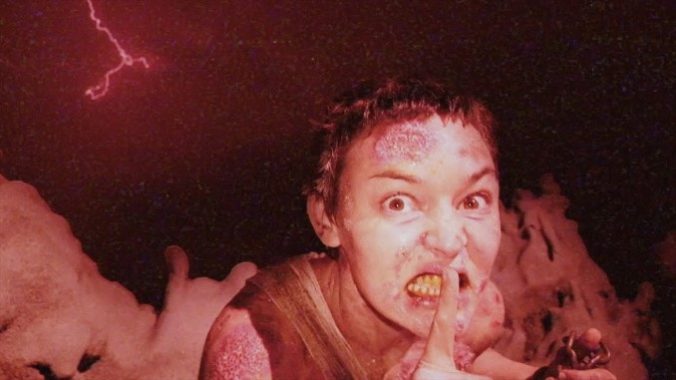Running Low on Ideas, V/H/S/99 Cribs from Itself
Photos via Shudder
Last year’s V/H/S/94 was an unexpected and welcome return for the horror genre’s premier found footage anthology series—not that it exactly has a lot of franchise competitors—which had not seen an entry since 2014’s disappointing V/H/S: Viral seemingly killed off the concept. That film was unbalanced even by anthology standards, but the lopsidedness was clearly intentional: V/H/S/94 primarily functions as a delivery device for the astoundingly creative, gory and bonkers short “The Subject” by director Timo Tjahjanto, which dominates the entire center of the film. The overall effect was like an experiment in using an anthology as something more akin to a progressive dinner, with Tjahjanto’s entry as the obvious entrée, surrounded by a platter of smaller amuse-bouches.
Shudder’s follow-up V/H/S/99, on the other hand, is a far more conventional spin on the horror anthology formula, relatively evenly weighted with a variety of stories from the usual assembly of up-and-coming horror filmmakers. So too is the visual language and quality level of its segments more consistent. The only problem? All of those segments feel on the staid side, with none coming anywhere close the heights of past V/H/S entries, and several simultaneously feel conceptually indebted to prior installments. The feeling is one of depletion, as V/H/S/99 begins robbing past hits in a grim effort to keep itself mobile and vital.
Which is to say, it all feels on the tired and lifeless side—there’s no segment here that contains half of the audacious visual stylings of “The Subject,” or even the pure creepiness of the setting in a segment like Chloe Okuno’s “Storm Drain.” Too many of these concepts feel instantly familiar, and the segments as a whole lack even the most basic connective tissue to tie them together in a broader thematic sense, other than the obvious year at the end of the title. This is largely due to the overall absence of a framing device/overarching storyline, as was seen in previous V/H/S installments. These framing device sequences are rarely series highlights, but when employed well (as in the abandoned house setting of the original V/H/S) they can add to the creep factor of what otherwise feels like disembodied pieces of footage. In the original V/H/S, we felt like we were looking in on forbidden pieces of apocrypha, collected by a sick mind. Here, it’s more like we’re channel surfing through student film submissions.
The highlight here, at least to most viewers, is likely to be Flying Lotus’ “Ozzy’s Dungeon,” positioned in the middle of the feature as its anchor. In its opening moments, it’s immediately clear the kind of mid-’90s parody we’re engaging in here, on the set of a kids’ game show in the style of Legends of the Hidden Temple or Guts. The execution is fine, and Steven Ogg gives it his all as the obnoxious host, indifferent to the suffering of the child contestants, but it’s difficult to square the comedic nostalgia grab—better executed in something like Netflix’s underseen Saturday Morning All Star Hits!—with the second portion of the segment, which sees the kid’s family enacting grisly revenge on Ogg’s host with their own obstacle course of horrors. This gross, misanthropic turn just feels like wallowing in misery for its own sake, replete with characters constantly hacking, coughing, sputtering and phlegmy, as if a concerted effort is being made to render the story as aesthetically grimy as possible. But still, “Ozzy’s Dungeon” isn’t done, as it takes yet another stylistic turn in an over-the-top supernatural conclusion that turns into a literal facemelter, albeit one rendered so shakily that it’s hard to have anything beyond a basic idea of what is going on. Still, among the V/H/S/99 segments, this is the one taking the biggest risks, but that’s mostly by virtue of the others playing things very conventionally indeed.
-

-

-

-

- Curated Home Page Articles By Test Admin October 21, 2025 | 3:10pm
-

- Curated Home Page Articles By Test Admin October 21, 2025 | 2:57pm
- Urls By Test Admin October 21, 2025 | 2:57pm
- Curated Home Page Articles By Test Admin October 21, 2025 | 2:55pm
-

-

-

-

-

-

-

-

-

-

-

-

-

-

-

-

-

-

-

-

-

-

-

-

-

-

-

-

-

-

-




































